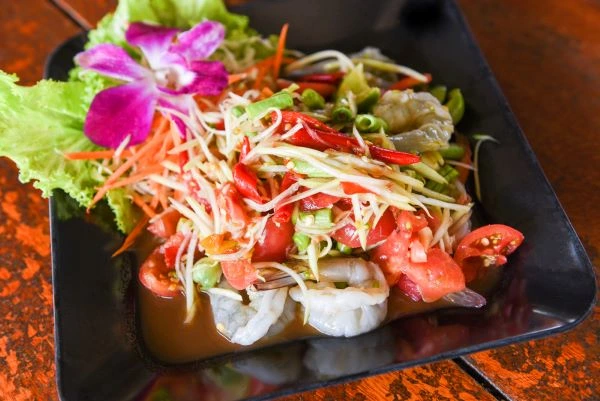Discovering Thai Cuisine: A Journey Through Flavors, Dishes, and Ingredients from Thailand
Thai cuisine is renowned around the world for its bold flavors, vibrant colors, and rich cultural history. Whether it's the fresh ingredients, aromatic herbs, or the perfect balance between sweet, sour, salty, and spicy, Thai food offers something for everyone. If you’re curious about the most famous dishes, ingredients, or what makes Thai food so special, you’ve come to the right place.
In this blog, we’ll explore the essential ingredients in Thai cuisine, the most popular dishes, what makes Thai food unique, and much more. If you’ve ever wondered where the ingredients come from or whether Thai food is spicy, we’ve got you covered. Plus, we’ll even give you tips on how to make spicy dishes more manageable.

What Are the Most Important Ingredients in Thai Cuisine?
At the heart of Thai cuisine are a few key ingredients that define its distinctive flavors. These ingredients are used across various dishes and bring out the essence of Thailand’s culinary tradition.
Rice: Rice is a staple in Thailand, often served with nearly every meal. Jasmine rice, known for its fragrant aroma and fluffy texture, is the most common variety used in Thai cooking. It’s served alongside curries, grilled meats, and seafood dishes.
Fish Sauce (Nam Pla); Fish sauce is an essential ingredient that adds a savory, umami flavor to Thai dishes. Made from fermented fish, it’s used in sauces, soups, and stir-fries to impart a salty depth.
Coconut Milk: Coconut milk is a key ingredient in many Thai curries and soups, such as Tom Kha Gai (chicken coconut soup). It adds a creamy texture and rich, slightly sweet flavor to dishes.
Lemongrass: Lemongrass provides a citrusy and fresh flavor to Thai soups and curries. It is often used in Tom Yum soup and other brothy dishes.
Galangal: Galangal, a root similar to ginger but with a more peppery, citrusy flavor, is another vital ingredient in Thai cooking. It’s typically used in soups and curries like Tom Yum and Green Curry.
Kaffir Lime Leaves: These fragrant leaves give Thai dishes a distinct citrus flavor, often found in soups, curries, and salads. The leaves are shredded or used whole for flavoring and are a crucial part of many recipes.
Chilies: Thai cuisine is known for its heat, and fresh chilies are a central ingredient in many dishes. The level of spice can range from mild to extremely fiery, depending on the variety of chili used.
Thai Basil: Thai basil, which has a sweet, slightly spicy flavor, is used in numerous stir-fries and curries, most famously in Pad Kra Pao, a stir-fried dish featuring holy basil.
Palm Sugar: Palm sugar adds sweetness to Thai dishes, balancing out the heat and sour notes. It is often used in curries, sauces, and desserts.
Tamarind: Tamarind is a sour fruit used to add tanginess to Thai dishes. It’s found in sauces, soups, and some curries, as well as the famous Pad Thai.
These ingredients come together to create the signature flavors of Thai cuisine. Whether you're making a curry, stir-fry, or soup, these ingredients are the backbone of the cuisine.
What Are the Most Famous Dishes in Thai Cuisine?
Thai food is diverse and offers a range of dishes that are loved both within Thailand and internationally. Here are some of the most famous Thai dishes:
Pad Thai: Perhaps the most well-known Thai dish worldwide, Pad Thai is a stir-fried noodle dish made with rice noodles, shrimp or chicken, peanuts, eggs, and bean sprouts, all tossed together with tamarind paste, fish sauce, and lime. It’s a perfect balance of sweet, salty, sour, and spicy.
Green Curry (Gaeng Keow Wan): Thai green curry is a rich, creamy dish made with green curry paste, coconut milk, vegetables, and protein, usually chicken, beef, or fish. The spicy and aromatic flavors are intensified with fresh herbs and spices like kaffir lime leaves and Thai basil.
Tom Yum Goong (Spicy Shrimp Soup): Tom Yum is a fragrant and flavorful soup made with shrimp, lemongrass, galangal, kaffir lime leaves, and fresh chilies. It’s a perfect combination of spicy, sour, and savory flavors.
Som Tum (Papaya Salad): Som Tum is a spicy salad made with shredded green papaya, tomatoes, green beans, peanuts, and chilies, all tossed with a tangy dressing made from fish sauce, lime juice, and sugar. It’s a perfect side dish to balance out the richness of Thai curries.
Massaman Curry: Massaman curry is a fusion of Thai and Indian flavors, with a rich, mildly spicy curry base made from spices like cinnamon, cumin, and cardamom. It’s typically made with beef, chicken, or lamb, along with potatoes and peanuts.
Pad Kra Pao (Basil Stir-Fry): A popular street food dish, Pad Kra Pao consists of stir-fried meat (often chicken or pork) with garlic, chilies, and Thai basil, served over rice. It’s typically topped with a fried egg for extra flavor.
Khao Pad (Thai Fried Rice): Khao Pad is a simple but flavorful fried rice dish, often made with shrimp, chicken, or pork, and mixed with onions, eggs, and vegetables. It’s a versatile dish that can be found at almost every street food stall.
Tom Kha Gai (Chicken Coconut Soup): This creamy and fragrant soup features chicken, coconut milk, galangal, lemongrass, and kaffir lime leaves. It’s mildly spicy and sour, making it a comforting dish for any occasion.
What Makes Thai Food So Special?
What truly sets Thai cuisine apart is its balance of flavors. Thai food is famous for its harmony of sweet, salty, sour, and spicy elements in every dish. These contrasting flavors come together in a way that delights the taste buds, offering a complex yet refreshing eating experience.
Thai food is also characterized by the use of fresh, high-quality ingredients, many of which are locally grown. Herbs, vegetables, fruits, and spices are often sourced directly from local farms, ensuring the food is fresh and full of flavor.
Another aspect that makes Thai cuisine special is its presentation. Thai dishes are often beautifully arranged, showcasing vibrant colors that make the food visually appealing. This attention to detail elevates the dining experience and reflects Thailand's emphasis on beauty and balance in all things.
Where Do the Ingredients Come From?
The majority of ingredients used in Thai cuisine are grown locally in Thailand's fertile agricultural regions. Rice, for example, is cultivated in the central plains, while tropical fruits like mango, papaya, and coconut are harvested from the southern parts of the country.
Many of the herbs and spices used in Thai cooking, such as lemongrass, galangal, and kaffir lime, are grown in the country's warm and humid climate. The coastal regions provide an abundance of seafood, while the inland areas supply meats like chicken, pork, and beef.
What Is the Oldest Thai Dish?
One of the oldest and most traditional dishes in Thai cuisine is Khao Chae. This dish, which dates back over 300 years, consists of rice soaked in cold, fragrant water, typically served with fried shrimp paste balls, vegetables, and sweet and savory condiments. Khao Chae was once a royal dish, enjoyed during the hot summer months.
Is Thai Food Spicy?
Yes, Thai food is often quite spicy, thanks to the use of fresh chilies and spicy curry pastes. However, the spice level can vary from dish to dish. For those not used to heat, many restaurants offer a mild version of spicy dishes. Thai cooks are skilled at balancing the heat with sweetness, sourness, and saltiness, so even spicy dishes are often enjoyable for those who prefer milder flavors.
How Can You Make Spicy Food Less Spicy?
If you find a dish too spicy for your taste, there are a few simple ways to tone down the heat:
Add Dairy: Dairy products, like milk or yogurt, can help neutralize the spice. A spoonful of coconut milk can also help balance the heat in Thai curries.
Increase the Sweetness: Adding sugar, honey, or palm sugar can help balance the heat. Thai food often uses sweetness to offset the spiciness.
Serve with Rice: Serving spicy dishes with a generous amount of rice can help dilute the heat, as rice absorbs some of the spice.
Remove the Chilies: In some dishes, the chilies are added for flavor rather than heat. If you're cooking at home, you can reduce the number of chilies or remove them entirely for a milder version.
Conclusion: A Culinary Adventure Awaits in Thai Cuisine
Thai cuisine offers an unforgettable culinary journey, where every dish tells a story of rich tradition, vibrant flavors, and perfect balance. From the iconic Pad Thai to the fiery Tom Yum, every bite immerses you in the heart of Thailand’s diverse culture. The freshness of the ingredients, the meticulous balance of flavors, and the artistry in presentation all make Thai food truly exceptional. Whether you’re a fan of spicy dishes or prefer something milder, Thai cuisine has something to suit every palate.
So, why wait? Embark on your own Thai culinary adventure today. Explore new recipes, experiment with authentic Thai ingredients, and discover the flavors that make Thailand’s dishes so beloved around the world. Don’t just read about Thai food—taste it, cook it, and savor it!

















































Comments